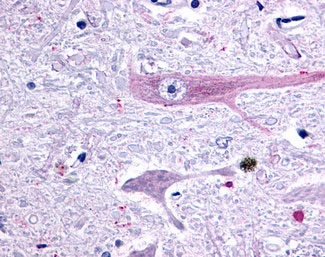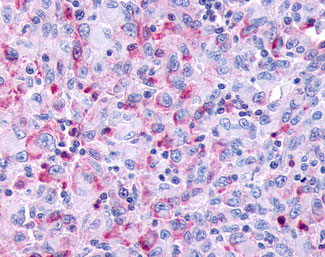GPR75 Antibody (Cytoplasmic Domain)
Rabbit Polyclonal Antibody
- SPECIFICATION
- CITATIONS
- PROTOCOLS
- BACKGROUND

Application
| IHC-P |
|---|---|
| Primary Accession | O95800 |
| Reactivity | Human, Monkey |
| Host | Rabbit |
| Clonality | Polyclonal |
| Calculated MW | 59kDa |
| Dilution | IHC-P (20 µg/ml) |
| Gene ID | 10936 |
|---|---|
| Other Names | Probable G-protein coupled receptor 75, GPR75 |
| Target/Specificity | Human GPR75. BLAST analysis of the peptide immunogen showed no homology with other human proteins. |
| Reconstitution & Storage | Long term: -70°C; Short term: +4°C |
| Precautions | GPR75 Antibody (Cytoplasmic Domain) is for research use only and not for use in diagnostic or therapeutic procedures. |
| Name | GPR75 |
|---|---|
| Function | G protein-coupled receptor that is activated by the chemokine CCL5/RANTES. Probably coupled to heterotrimeric Gq proteins, it stimulates inositol trisphosphate production and calcium mobilization upon activation. Together with CCL5/RANTES, may play a role in neuron survival through activation of a downstream signaling pathway involving the PI3, Akt and MAP kinases. CCL5/RANTES may also regulate insulin secretion by pancreatic islet cells through activation of this receptor. |
| Cellular Location | Cell membrane; Multi-pass membrane protein |
| Tissue Location | Expressed at high levels in brain and spinal cord and at detectable levels in retinal pigment epithelium. In situ hybridization of adult eye sections localized transcripts only to the perivascular cells, surrounding retinal arterioles, in the ganglion cell/nerve fiber layer. Also expressed by islet cells (at protein level). |
| Volume | 50 µl |

Thousands of laboratories across the world have published research that depended on the performance of antibodies from Abcepta to advance their research. Check out links to articles that cite our products in major peer-reviewed journals, organized by research category.
info@abcepta.com, and receive a free "I Love Antibodies" mug.
Provided below are standard protocols that you may find useful for product applications.
Background
G protein-coupled receptor that is activated by the chemokine CCL5/RANTES. Probably coupled to heterotrimeric Gq proteins, it stimulates inositol trisphosphate production and calcium mobilization upon activation. Together with CCL5/RANTES, may play a role in neuron survival through activation of a downstream signaling pathway involving the PI3, Akt and MAP kinases. CCL5/RANTES may also regulate insulin secretion by pancreatic islet cells through activation of this receptor.
References
Tarttelin E.E.,et al.Biochem. Biophys. Res. Commun. 260:174-180(1999).
Ota T.,et al.Nat. Genet. 36:40-45(2004).
Hillier L.W.,et al.Nature 434:724-731(2005).
Mural R.J.,et al.Submitted (SEP-2005) to the EMBL/GenBank/DDBJ databases.
Liu B.,et al.Diabetologia 56:2467-2476(2013).
If you have used an Abcepta product and would like to share how it has performed, please click on the "Submit Review" button and provide the requested information. Our staff will examine and post your review and contact you if needed.
If you have any additional inquiries please email technical services at tech@abcepta.com.













 Foundational characteristics of cancer include proliferation, angiogenesis, migration, evasion of apoptosis, and cellular immortality. Find key markers for these cellular processes and antibodies to detect them.
Foundational characteristics of cancer include proliferation, angiogenesis, migration, evasion of apoptosis, and cellular immortality. Find key markers for these cellular processes and antibodies to detect them. The SUMOplot™ Analysis Program predicts and scores sumoylation sites in your protein. SUMOylation is a post-translational modification involved in various cellular processes, such as nuclear-cytosolic transport, transcriptional regulation, apoptosis, protein stability, response to stress, and progression through the cell cycle.
The SUMOplot™ Analysis Program predicts and scores sumoylation sites in your protein. SUMOylation is a post-translational modification involved in various cellular processes, such as nuclear-cytosolic transport, transcriptional regulation, apoptosis, protein stability, response to stress, and progression through the cell cycle. The Autophagy Receptor Motif Plotter predicts and scores autophagy receptor binding sites in your protein. Identifying proteins connected to this pathway is critical to understanding the role of autophagy in physiological as well as pathological processes such as development, differentiation, neurodegenerative diseases, stress, infection, and cancer.
The Autophagy Receptor Motif Plotter predicts and scores autophagy receptor binding sites in your protein. Identifying proteins connected to this pathway is critical to understanding the role of autophagy in physiological as well as pathological processes such as development, differentiation, neurodegenerative diseases, stress, infection, and cancer.



